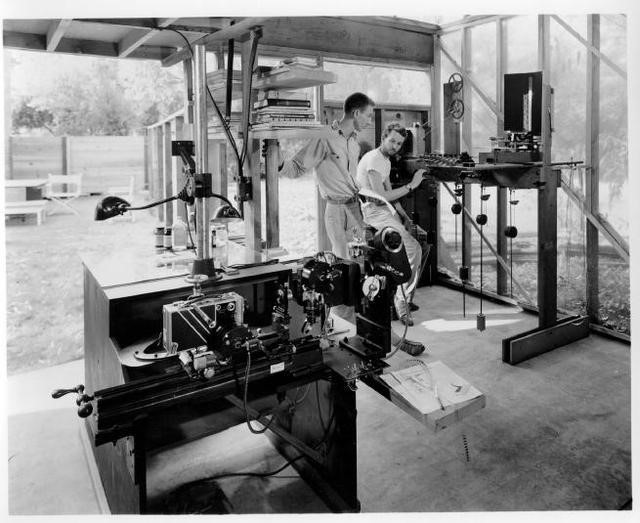John Whitney as a pioneer of computer graphics and the IBM 2250 as a tool for creating computer video effects

John Whitney and Source: hackpad.com
Long before the beginning of the active distribution of computer graphics in movies and cartoons, even before the founding of Pixar, computer animation itself existed in rudimentary form. Tens of years ago, no one rendered a video sequence on a PC, and there were no computer-modeled scenery.
But at that time there lived and worked a man who made all this possible. This is John Whitney, the pioneer of computer graphics. He had a fairly wide range of interests, and he especially wanted to know one thing - is it possible to create works of art, artwork with the help of computers? Hardly for someone from readers Geektimes the answer "yes" will be a surprise. John Whitney was able to realize his idea, and he did it in a big way.
Whitney first worked with analog PCs (he created them himself). His most famous project in this regard is spirographic animation (screensaver) for Alfred Hitchcock’s film “Dizziness”, created in 1958. To develop this animation, he and his brother built a special computer, based on the anti-aircraft fire control device - predictor Kerrison .
')

It was from this that an analog computer was made that made it possible to achieve an animation sequence known to many from the film mentioned above (source: Wikipedia)
Whitney began experimenting with other types of animation, as a result he managed to achieve a lot. His mechanical computers allowed, for example, to do this:
This schedule was new for its time, a little like that. After some time, Whitney began working at IBM, because the corporation was interested in his projects. It happened in 1966. The capabilities of the company allowed Whitney to start working with full-fledged computers, moreover, with the most advanced at that time mainframe line of IBM System / 360. IBM System / 360 (S / 360) is a family of mainframe class computers, which was announced on April 7, 1964. It was the first row of computers in which a clear distinction was made between architecture and implementation. Thanks to this system, it was possible to create a full-fledged visualization with audio. The mainframe could be updated by adding more advanced modules.
Note that the further development of IBM / 360 are the systems 370, 390 and System z (the newest representative of the line is IBM z13s ). The IBM / 360 architecture was so successful that it became the de facto industry standard until today.
A few years later, Whitney began to create even more advanced animations, like this:
This video was created using a vector display. It uses “harmonic progression” and Arabic architecture as the basis. With music, Manoochehr Sadeghi graphics has become an almost perfect combination of video and sound. Whitney also worked with one of the first digital graphic tools, the IBM 2250. There is a CRT monitor, an alphanumeric keyboard, a fiber optic light stylus, and a programmable keyboard.

Dr. Jack Citron at work
At 2250, Whitney worked with a modified set of variables and operators for FORTRAN, which was called GRAF (Graphic Additions to FORTRAN). GRAF was created specifically for him by programmer Jack Citron (Jack Citron). Whitney successfully used the new software in his works, including in documentaries for IBM.
With GRAF, Whitney managed to put together complex visual patterns into a single system, to which color and even sound was added. It worked like this:
1. IBM 2250 was used to set image sequence parameters;
2. Punch cards were used to control such a sequence using a modified 35 mm camera;
3. A 35-mm negative appeared, and graphic sequences were processed, with the addition of color using a DIY optical printer created by Whitney.
The technique developed, and Whitney created more and more sophisticated graphic elements:
It is thanks to this person that we received computer graphics, because Whitney was able to achieve the recognition of computer technology by the same artists who, now, having transferred for PCs, became known as graphic designers. Perhaps, without Whitney, progress in this area would have been noticeable, but the modern world would look a little different, this is undoubtedly so.
Source: https://habr.com/ru/post/394697/
All Articles